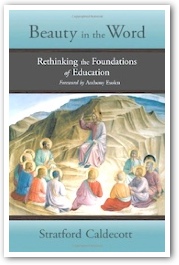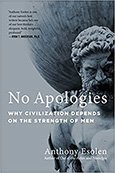Foreword to Beauty in the Word
- ANTHONY ESOLEN
I should like to introduce Stratford Caldecott's wonderful and much needed book with an anecdote, followed by a brief survey of the wasteland.
 |
A few years ago I was at a book sale, at a local library in Canada. I hadn't found anything I liked, so a young girl came up to me to ask if she could help. She was a worker at the library, and was about to enter the most esteemed college in eastern Canada. 'What are you interested in?' she asked.
That was a hard question for me to answer, since we didn't really speak the same language. I could have said, 'Perceptive works in philosophy and theology,' or 'Great European novels,' but I don't think that would have advanced the conversation. I finally said that I was a college professor, and when she asked me what I taught, I mentioned Dante and the Divine Comedy. 'I don't mean any disrespect for your favorite author,' she said, smiling, 'but I've never heard of him.'
I could multiply this anecdote many times over. From what my freshmen now tell me, public schools in the United States have virtually abandoned the study of literature written before 1900, and their neglect of poetry in general is more thoroughgoing still. Some few of them have read perhaps a sonnet by John Donne, typically 'Death, Be Not Proud,' or a piece of the prologue of Chaucer's Canterbury Tales. Sometimes there's a play by Shakespeare, a Macbeth or Romeo and Juliet, taught, of course, without any reference to the Christian faith that formed the world wherein Shakespeare and his audience found their home. It's not as if their place were taken by the quintessentially American mythographers and poets. Hawthorne rarely makes it into the room; Melville and Longfellow more rarely still. Huckleberry Finn has fallen victim to political sensitivities, despite Twain's heroic championing of the goodness and wisdom of the slave, Jim. Robert Frost is forgotten, even in New England. James Fenimore Cooper is forgotten, even in New York. I am informed by my British colleagues that if I entertain some quaint notion that Wordsworth and Coleridge are remembered in England, I am seriously mistaken.
And yet somehow that neglect isn't the worst of it. When I find out what they do read, I'm struck by what can only be described as a perverse refusal to assign literature of any real beauty. There are the political novels, the exploration of what is ugly and tawdry in the modern world, and books assigned to 'open' the mind by exposing it to a favorite perversion, with a dash of obscenity or pornography to season the dish. The same faults may be found in the forgetting of history, and the turn towards the ephemera of current events; or in the neglect of the logic of language, grammar, for the benefit of self-expression, preferably of the daintily crude variety. I am tempted to conclude that there are only two things wrong with our schools: what they don't teach our children, and what they do.
That is where the criticism of our schools usually begins and ends. I don't wish to deny the validity of that criticism; it is scandalous that children in England will not know who Thomas Becket was, or that children in America will not know what happened at Yorktown. But as Stratford Caldecott so beautifully shows in his much-needed work, we suffer the consequences of a more fundamental error still. We do not know what or how to teach children, because we do not know what a child is, and we do not know what a child is, because we do not know what man is and Him from whom and for whom man is.
How decisive for the Christian educator, or for any educator of good will, is the revelation that man is made in the image and likeness of the three-Personed God? That is like asking what difference it will make to us if we keep in mind that a human being is made not for the processing of data, but for wisdom; not for the utilitarian satisfaction of appetite, but for love; not for the domination of nature, but for participation in it; not for the autonomy of an isolated self, but for communion. It is no accident that Caldecott has structured his plan for a true education upon the three ways of the Trivium, which themselves reflect the three primary axes of being, revealed by God: of knowing, that is to say giving; of being known, that is to say receiving; and of the loving gift. As Dante puts it:
O Light that dwell within Thyself alone,
who alone know Thyself, are known, and smile
with Love upon the Knowing and the Known!
|
If we did keep these things in mind, I doubt very much that we would trammel children up in great warehouses, built for the efficient delivery of services of quite dubious value. But more than that, we would desire to bring children into the garden of created being, and thought, and expression. Caldecott reminds us that for the medieval schoolmen, as for Plato, education was essentially musical, an education in the cosmos or lovely order that surrounds us and bears us up. Thus when we teach our youngest children by means of rhymes and songs, we do so not merely because rhymes and songs are actually effective mnemonic devices. We do so because we wish to form their souls by memory: we wish to bring them up as rememberers, as persons, born, as Caldecott points out, in certain localities, among certain people, who bear a certain history, and who claim our love and loyalty.
The memory, too, gives the child both the strength and the armor he needs for what comes next, and that is thought itself strength to search for truth, and armor against easy and plausible falsehoods. I often hear well-meaning people say that they do not teach children what to think, but how to think. What they mean is that they reward genuine thought, rather than thoughtless repetition of what the teacher has said. Yet this way of looking at things is wholly inadequate, because it does not originate in truth, nor does it have truth as its ardent aim. Consider an analogy. Suppose an art teacher should say, 'I do not teach my students what to draw, but how to draw.' Yet one cannot proceed one step in drawing without the what. The what and the how are inextricably bound. That is the case too for the relationship between memory and thought. Yes, there are rules of logic, which Caldecott, wise Socratic as he is, duly emphasizes. But he knows also that reason itself is far more than the nominally correct use of deductive rules. It involves the whole mind and its apprehension of the what outside: grass, and dogs, and rivers, and justice, and love. So the study of how to think is also a deepening of one's first memories, or one's first encounters with truth. Or we might put it another way, and say that the Son reveals to us the Father, and that the Son does only what He sees the Father do.
Yet what good would all this be to us, if we were to put the lamp under a bushel basket, or retire, guru-like, into the mountains, in calm separation from the lot of our fellow men? Thus Caldecott completes his art of education with Speaking: with the Spirit. He recalls for us the ruah or the breath of God, stirring upon the waters of creation; it is that same breath that inspired, literally in-breathed, the apostles at Pentecost. Only then could these very ordinary men go forth, in courage, to preach the good news of Jesus Christ. The Lord who made the mute to speak, made the disciples to preach. The art of rhetoric, the third course of the Trivium, is not for political gain, as the Sophists of ancient Greece once boasted that they could teach young m en to sway the democratic assemblies whichever way they would. It is for the attractive showing of truth: it wins for truth with eloquence, and beauty, and the love-born wish to bring others into communion with those who see that truth.
This is an education in reality the reality of the world, and of persons. It involves, in memory, the child's appropriation of realities; in thinking, the older child's exploration of those realities; in speaking, the youth's sharing of those realities with others, in a community. It is an education that penetrates the heart and the mind with light. After so long a journey into the depths of the drab and the dispirited, it is as if we were beckoned by this wise and happy man to ascend with him at last, and see, once more, the stars.
See Chapter 1 from Beauty in the Word by Stratford Caldecott
"Child, Person, Teacher: at the Heart of a Catholic School" here.
 This is J. Fraser Field, Founder of CERC. I hope you appreciated this piece. We curate these articles especially for believers like you.
This is J. Fraser Field, Founder of CERC. I hope you appreciated this piece. We curate these articles especially for believers like you.
Please show your appreciation by making a $3 donation. CERC is entirely reader supported.

Acknowledgement
Anthony Esolen. "Foreword." from Beauty in the Word: Rethinking the Foundations of Education by Stratford Caldecott (Tacoma, WA: Angelico Press, 2012): 3-6.
Reprinted by permission of Stratford Caldecott and Angelico Press.
The Author

Anthony Esolen is writer-in-residence at Magdalen College of the Liberal Arts and serves on the Catholic Resource Education Center's advisory board. His newest book is "No Apologies: Why Civilization Depends on the Strength of Men." You can read his new Substack magazine at Word and Song, which in addition to free content will have podcasts and poetry readings for subscribers.
Copyright © 2012 Anthony Esolen


